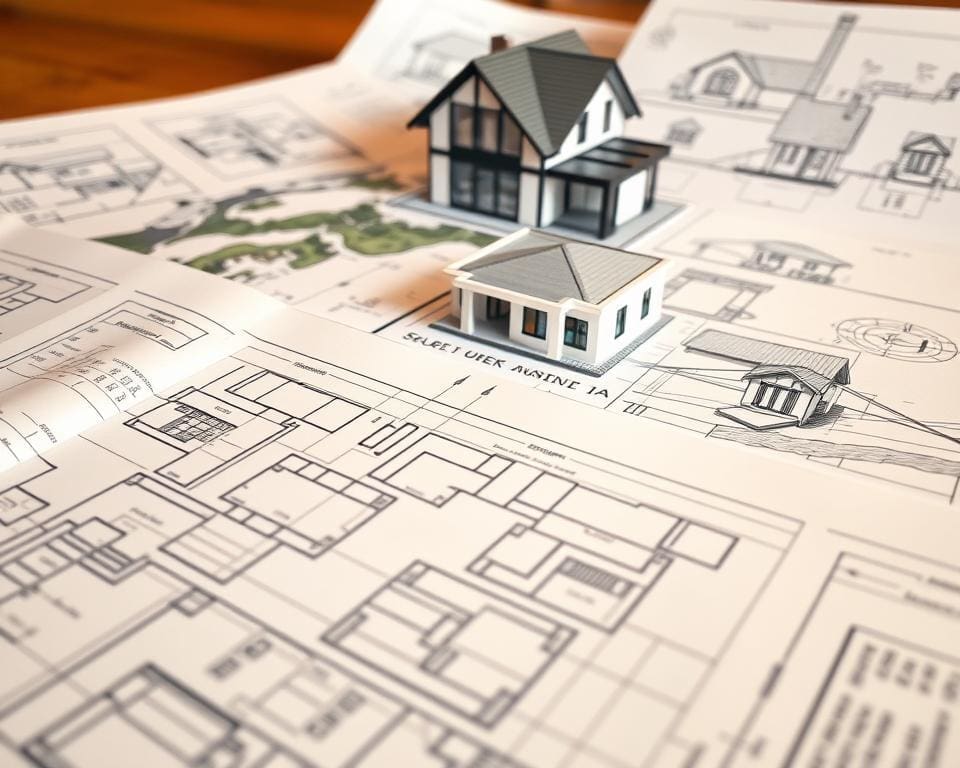Embarking on the journey of self-build home planning is a transformative experience that empowers individuals to create their dream dwelling from the ground up. Understanding the key steps in planning a self-build home is essential for turning aspirations into a reality. This custom-built home process begins with comprehensive research to navigate local regulations and best practices. From defining personal needs to embracing the rewarding challenge of managing your own project, meticulous planning is critical. Personalising your living space not only reflects your unique style but also enhances your quality of life, making every step along the way incredibly fulfilling.
Understanding the Concept of Self-Build Homes
Self-build homes offer a unique opportunity for individuals to create a living space tailored to their personal preferences and requirements. Engaging in self-building not only allows for creative control over the design but also presents various advantages that can lead to the ultimate dream home experience. Understanding the true essence of self-build homes uncovers the myriad benefits of self-building and debunks common self-build home misconceptions.
Definition and Benefits of Self-Building
A self-build home is constructed by an individual or group of individuals rather than a traditional homebuilder. This approach provides numerous benefits that appeal to many prospective homeowners. Key advantages include:
- Cost-effectiveness: Oftentimes, self-building can be more affordable than buying a pre-built home.
- Creative control: Homeowners dictate the design, layout, and materials used, ensuring the end product reflects their style.
- Energy efficiency: Self-builders can incorporate sustainable materials and energy-efficient designs to lower utility bills.
Common Misconceptions
Misperceptions about self-build homes can deter potential builders. Some common self-build home misconceptions include:
- The belief that self-building is only suitable for industry professionals with extensive construction experience.
- The assumption that significant financial backing is necessary to embark on a self-build journey.
Awareness of these misconceptions is essential for those considering this path. The growing popularity of self-building in the UK reveals a shift in mindset, supported by data from housing authorities and self-build organisations showcasing high satisfaction rates among self-builders.

Initial Considerations for Planning Your Self-Build
Embarking on a self-build adventure is both exciting and challenging. The first step involves a clear vision of what you want to achieve. This clarity is crucial in steering the project towards your aspirations. Understanding your goals is vital in making informed decisions throughout the journey.
Defining Your Goals and Needs
Setting out to realise a self-build home requires careful consideration of your personal goals. Take the time to assess family size, essential features, and preferred living conditions. Each of these factors plays a significant role in the design process. By defining goals for self-build, individuals can create a personalised living space that meets their needs effectively. Engaging loved ones in discussions about these aspects can further refine your vision, ensuring everyone’s wishes are accounted for.
Budgeting for Your Self-Build Project
Realising your dream home demands a solid financial plan. Budgeting for a self-build home encompasses various elements. Start by calculating costs for land, materials, and labour, considering potential unexpected expenses along the way. Adopting a realistic approach to financial planning will create a buffer for any unforeseen challenges during the build. Consulting with financial advisors can provide invaluable insights into effective budgeting techniques. Explore self-build mortgage options to support your project financially, ensuring a stable foundation for your journey ahead.
What are key steps in planning a self-build home?
Embarking on a self-build journey involves multiple pivotal steps that can set the foundation for a successful project. Understanding local building regulations, careful site selection, and engaging with local communities are essential components that contribute to a well-planned initiative.
Researching Local Building Regulations
Before taking any steps forward, a thorough understanding of local building regulations is crucial. These regulations dictate what can be built, how it should be constructed, and what permits are necessary. Familiarising oneself with these laws ensures compliance and avoids unexpected delays or fines during the construction process.
Site Selection: Choosing the Right Location
Choosing the right location is vital when selecting site for self-build. Factors such as proximity to amenities, public transport links, and the overall environment should guide this decision. Evaluating the suitability of the area not only influences daily life but can affect long-term property value.
Engaging with Local Communities
Engaging local communities can provide insights that enhance the self-build experience. Building relationships with residents often leads to valuable advice about the neighbourhood and local culture. This connection fosters a sense of belonging and can aid in aligning designs with community standards, ultimately benefitting the project as a whole.
Designing Your Dream Home
Creating your ideal living space involves a deep connection to personal style and functionality. Through self-build property design, you have the unique opportunity to express your individual taste while ensuring that the home meets your practical needs. Understanding the various architectural styles for self-build projects plays a crucial role in this journey.
Finding Your Architectural Style
When embarking on your self-build adventure, identifying the architectural style that resonates with you provides a solid foundation for your design process. Popular styles include:
- Modern: Characterised by sleek lines and innovative materials.
- Traditional: Features classical elements and timeless designs.
- Eco-friendly: Incorporates sustainable practices and energy-efficient solutions.
In exploring these different approaches, think about how you want your home to reflect your values and lifestyle. This personal touch will enhance your living experience, making your self-build property a true representation of you.
Working with an Architect or Designer
Engaging with a professional offers invaluable benefits for your self-build journey. Working with an architect or designer ensures that your concepts evolve into practical and compliant designs. They bring insightful innovations and expertise in local building regulations that can greatly influence the success of your project. Architects can also assist in maintaining functionality while adhering to your aesthetic desires.
Collaboration with a professional facilitates a seamless integration of creativity and practicality, allowing you to navigate the complexities of self-build property design effectively. The right architect not only helps enhance your vision but also ensures your project stands the test of time, both functionally and stylistically.
Step-by-Step Guide to Self-Build Project Management
Managing a self-build project can be an exhilarating yet challenging endeavour. A solid approach to self-build project management will ensure success from conception to completion. Understanding how to effectively plan your build timeline is crucial. Selecting the right method, whether hiring contractors for self-build or managing tasks personally, impacts not only the budget but also the overall experience.
Planning Your Build Timeline
Creating a realistic timeline is integral to successful self-build project management. It is essential to break down the project into manageable stages, allowing clarity and focus. Consider these milestones when planning your build timeline:
- Initial design approval and securing permits.
- Site preparation and groundwork.
- Structural framework and major installations.
- Interior finishes and landscaping.
- Final inspections and moving in.
Each phase requires careful estimation of time and resources. Maintain flexibility in your timeline to accommodate unexpected challenges that may arise.
Hiring Contractors vs. Self-Managed Building
When it comes to self-build project management, deciding between hiring contractors and managing the building process independently is pivotal. Here are some considerations for both options:
- Hiring Contractors for Self-Build: Engaging professionals can offer experienced insights. They handle specific tasks efficiently, which can save time. However, this may come at a higher financial cost.
- Self-Managed Building: Taking on the project yourself allows for greater control and budget savings. This path requires significant time and commitment as you will handle all aspects of construction.
Evaluate your abilities, the complexity of the project, and the available time to determine which option suits your self-build aspirations best.
Securing Financing for Your Self-Build Project
Financing a self-build project can feel daunting, but understanding your options can pave the way for realising your dream home. Knowledge of self-build mortgages and alternative financing for self-build options can empower you to move forward with confidence.
Understanding Self-Build Mortgages
Self-build mortgages are tailored specifically for those looking to finance their own build projects. Unlike standard mortgages, these allow for staged payments, releasing funds at different construction phases. Expect a more involved application process that requires detailed plans and financial submissions. Lenders often assess the viability of the project more rigorously, focusing on the proposed designs and overall cost.
Alternative Financing Options Available
Besides self-build mortgages, several alternative financing for self-build avenues exist. Consider the following options:
- Loans from family members, providing funding with potentially lower interest rates.
- Crowdfunding platforms that connect you with investors interested in supporting your build.
- Government grants and schemes designed to encourage self-build housing initiatives.
Preparing comprehensive financial submissions can enhance your chances of securing funding. Simple case studies show numerous builders have successfully navigated the financing self-build project waters by employing creative funding solutions.
Navigating the Construction Process
The construction process self-build is an exciting journey, guiding you from the initial groundwork to the finishing touches of your new home. Understanding the various stages of building a house can make this task more manageable. Each phase demands attention and preparation, ensuring that everything runs smoothly. From laying down a robust foundation to installing plumbing and electrical systems, being aware of what to expect will greatly aid your self-build experience.
Key Stages in Building Your House from Scratch
Every self-build project encompasses several key stages. These include:
- Site Preparation: Clearing and levelling the land, as well as obtaining necessary permissions.
- Foundation Work: Laying a strong foundation is crucial for structural integrity.
- Framing: Constructing the skeleton of your house, including walls, roof, and floors.
- Roofing: Ensuring your home is protected from the elements.
- Utilities Installation: Setting up plumbing, electrical wiring, and HVAC systems.
- Interior Finishes: Installing flooring, painting, and adding fixtures to complete your space.
How to Handle Delays and Issues
Handling construction delays is an inevitable part of the self-build journey. Challenges such as supply chain issues or unexpected weather can push timelines. Effective strategies for managing these setbacks involve:
- Maintaining a flexible timeline to accommodate unforeseen delays.
- Establishing good communication with contractors and suppliers.
- Securing a contingency budget to cover unexpected costs.
- Documenting all aspects of progress to identify areas needing attention.
Learning from seasoned builders who have navigated obstacles can provide invaluable insights into effective problem-solving techniques, guiding you through your own construction process. Embrace the challenges as part of your journey, and each step will bring you closer to your dream home.
Final Touches and Moving In
As your self-build journey comes to a close, the final touches for self-build homes become significant. These last steps ensure that you’re ready to embrace your new space. Conducting thorough final inspections is essential, confirming not just the quality of construction but also securing occupancy permits and certifications that pave the way for a smooth transition into your new sanctuary.
Preparing for move-in involves careful planning; scheduling utility connections, ensuring internet installation, and arranging your furniture can dramatically ease the transition. It’s the perfect time to think about how you want to personalise your home, from selecting décor that reflects your style to planning your garden layout. Every detail matters in creating a living space that truly feels like home.
Reflecting on experiences from recent self-builders, it’s clear that thoughtful preparation enhances the joy of moving into a self-build home. The excitement of not just relocating but starting a new chapter in a space crafted entirely to your vision is immeasurable. With these practical tips, you can navigate the final stages seamlessly and make the most of your new beginning.









